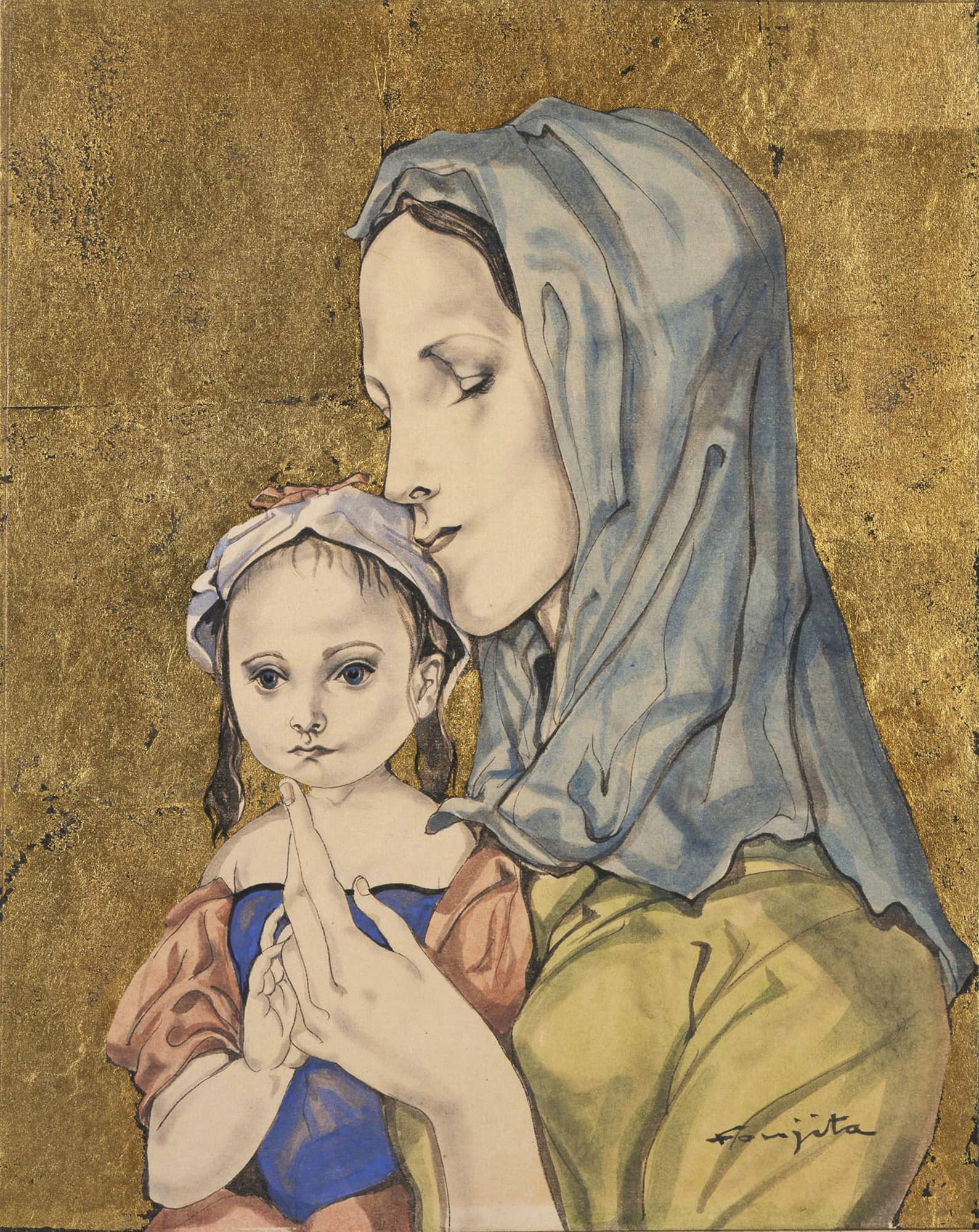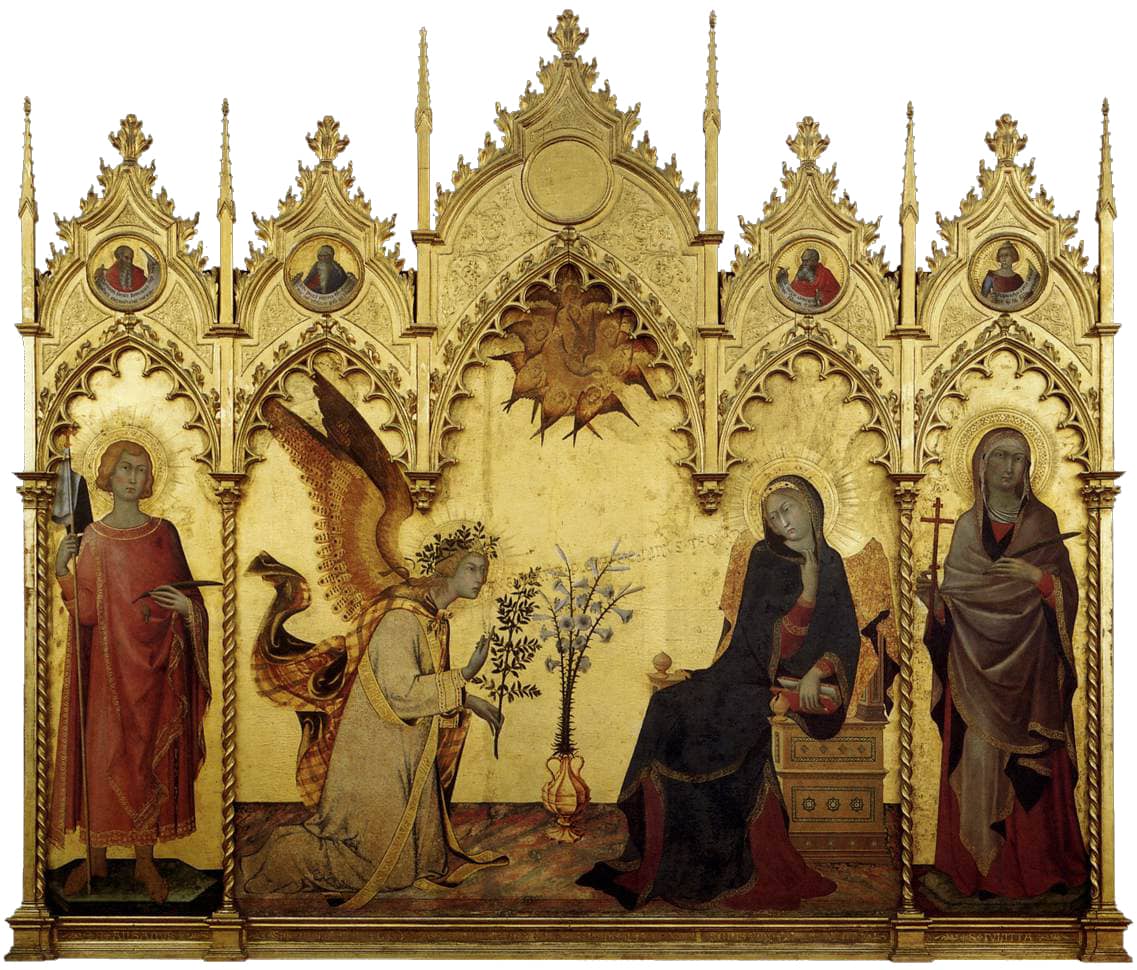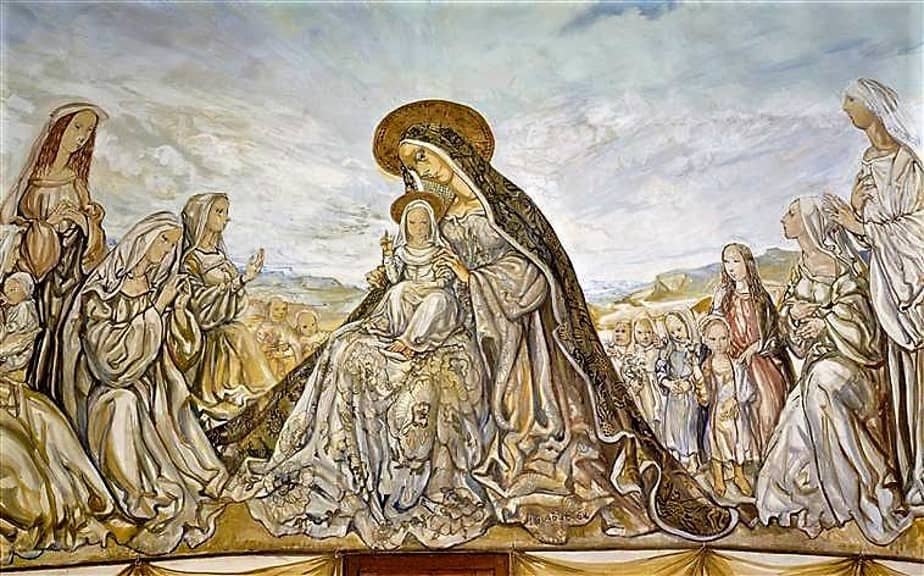Foujita’s Madonnas

Foujita
Mother and Child, c. 1959
Watercolour, gouache and ink on fold leaf laid down on
cardbord, 23 x 18.5 cm
Private collection, Paris
Photo credit: Courtesy Archives Artistiques Sylvie Buisson, Paris
© Fondation Foujita / ADAGP, Paris, 2020
A modern Japanese artist, Léonard Tsugouharu Foujita is an essential figure of 20th century avant-garde painting. A Franco- Japanese artist, he combined in his works the delicacy and finesse of Oriental painting and the audacity of modern western art. The female figure is undeniably at the heart of his work, from the nude to the veiled virgin, this motif was always a source of inspiration for Foujita.
The memory of a mother who passed away prematurely
The painter Foujita was born into a prosperous and cultivated family, open to progressive ideas and turned towards the West and modernity. His father, a general in the Japanese imperial army and a doctor, very quickly supported his son in his vocation to become an artist. His mother Masa was a loving and reassuring presence, who reigned over the four children. Foujita was especially close to her : she was a central figure in his early childhood.
Then drama struck : he lost his mother at barely five years old. This happened during the summer of 1891 at Kumamoto on the island of Kyushu, where the family had been living for three years. “My old servant arrived at the pond to look for us, the house was silent. I found my mother cold, dressed in white, a turned screen around her” said Foujita. This was a shock for the small child that he was at the time. The vision of his cold and pallid mother left a profound mark. The maternal figure was irreplaceable and Foujita took refuge in drawing and painting : this became his respiration, his vital energy.
Foujita at the Heart of the School of Paris
After training at the Tokyo Fine Art School, the artist painter Foujita left Japan for France, to his delight. He arrived in Paris on 6 August 1913 for a three year period of study, settling first in the cosmopolitan quarter of Montparnasse, then the Nouvelle Athènes after Montmartre. Montparnasse was for Foujita a reminder of the ukiyo the “floating world” of the red light districts of Toyo with its brothels, chashitsu (tea rooms) and its kabuki theatres.
As soon as he arrived, the painter Foujita met Pablo Picasso and plunged into the avant-garde universe. He immersed himself fully in the cosmopolitan group of painters of the School of Paris with which he formed strong connections. They were foreign, Pablo Picasso and Amedeo Modigliani, Ossip Zadkine, Chaïm Soutine, Marc Chagall, Kees van Dongen, Constantin Brancusi, and French, Guillaume Apollinaire, André Derain, Georges Braque and Marie Laurencin. These friendships, were a source of mutual inspirations and a strong aesthetic impact.

Amedeo Modigliani
The Blue-Eyed Woman, c. 1918
Oil on canvas, 81 x 54 cm
Musée d’Art moderne de Paris
Foujita’s art, a Bridge Connecting East and West
Very quickly, the painter Foujita was attracted by Western modernity. France fascinated him, especially Paris. As a child, he had asked to study French in the catholic school of the Marianist brothers in Tokyo. When he arrived in Paris, he soaked up Western art, without however rejecting his Japanese identity. Too old to attend the École Nationale Supérieure des Beaux-Arts of Paris, he taught himself about Western art. He obtained permission to make copies at the Louvre. During the Great War, he went there as many as three times a week and explored the museum with enthusiasm combined with curiosity and excitement, a thirst to learn, to discover and to innovate. Everything interested him, especially ancient art, the hieratic and rigorous characteristics of which were appealing, and Italian painting for its grace. “It had been predicted that I would be the most important painter in Japan, but I dreamed of being the most important painter of Paris : I had to go to the source,” said Foujita.
Anonymous, Crete
Virgin and Child, c. 1500
Oil on panel, 33.2 x 33.2 cm
Musée du Louvre, Paris

Leonardo da Vinci
The Virgin of the Rocks, 1483-1486
Oil on panel transposed onto canvas
199 x 122 cm
Musée du Louvre, Paris
Confronted by the painting of the great masters and the artistic revolution of the avant-garde artists, Foujita decided to be the bridge between the artistic identities of Europe and Japan. “Soon, he became conscious that he had to rethink not only his painting, but also his culture, and to form a future either by making a break, or by reconciling” to cite Anne Le Diberder, director of the
The artist Foujita House-Studio at Villiers-le-Bâcle. So he opted for conciliation, even “hybridization” to use the term adopted by Sylvie Buisson, the Foujita expert and author of the catalogues raisonnés of the artist, the fourth volume of which is currently being prepared. She also wrote that “no other Japanese artist before him had dared to transgress the conventions of his country. The precious nishikie prints enchanted him in the same way as Gothic and Renaissance Madonnas.” And he stated his ideal : “Allying the rigour of the Japanese line with the freedom of Matisse.”
From a technical point of view, the artist also allied the two heritages. While the avant-gardes favoured broad brushes, Foujita used the thin paintbrush of the meticulous painting of the Orient and used oil painting, specific to western art. In addition, he perfected his technical skills throughout his career, going as far as to combine oil and water on the same support.

Parmigianino
Study for the Madonna of the Long Neck, c. 1535
Red and white chalk, squared for transfer with red chalk
19.8 x 12.3 cm
Musée du Louvre, Paris
From the Nude to the Madonna, the Woman Celebrated
The woman is undeniably at the heart of the painter Foujita’s art. He loved women, who were for him an endless source of inspiration. In the effervescence and fury of the Années Folles, Foujita enjoyed clear success with his female nudes with their opaline whiteness, their porcelain complexion and lascivious poses that are finely erotic. In addition, this was a highly audacious subject for a Japanese painter. His models were of course his successive wives, Fernande, Youki, Madeleine and Kimiyo, and also the muses of Montparnasse : Misia Sert, Aïcha and Kiki and thousands of other sitters. Foujita confessed to having had over 3000 models during the Années Folles! Recruited at Le Dôme and La Rotonde cafés amongst other places.
But from his first years in Paris, Foujita was also drawn to mystical and religious subjects. For his fourth solo exhibition at the Galerie Chéron in Paris in 1919, he
exhibited twenty-five mystical compositions. These works were a surprise. Yet the artist, a pleasure seeker and night owl, had developed a mystical sensitivity very early. For him, “Buddhism, Shintoism and Catholicism were all the same in his mind. In Montparnasse, the Kabbalah and astrology were studied by a closed group of which Foujita, Modigliani and Max Jacob were members, as well as Zadkine who invited him to La Ruche to show him his golden Head of Buddha. Montparnasse proved to be the territory of liberty, exchanges and shared spirituality of which Foujita had dreamed” wrote Sylvie Buisson. She has emphasized that “While Chaïm Soutine was worshipping Rembrandt at the Louvre, going as far as to deify the carcass of a bull, Foujita was interrogating the masters of the Madonnas.”
Straight away, the feel for the sacred was shown by the use of gold leaf which links his paintings to small icons, a direct echo of Byzantine art.
In his first Madonnas, the painter Foujita created a reconciliation between Japanese and western art. He was influenced by Japanese prints, especially in the framing of the subject, just as the modernity of the avant-garde artists inspired his treatment of the body : the stretched bodies of Amedeo Modigliani’s figures, the slender evanescent bodies of Marie Laurencin, Brancusi’s oblong figures.
But it was also the early Italian artists, especially those from Siena that marked Foujita. Still close to Byzantine art with their gold leaf paintings, these artists sought to breathe life into the figures they depicted.

Simone Martini & Lippo Memmi
The Annunciation between Saint Ansanus and Saint Maxima,
1333
Tempera on wood, 265 x 305 cm
Galleria degli Uffizi, Florence
In Foujita’s art, figures, even the static ones, evoke movement, such as in this Mother and Child of 1918 in which the woman rouses the attention of her new-born by swinging a pair of cherries in a tender and candid composition.

Foujita
Mother and Child,1918
Watercolour, gouache, india ink and gold leaf on paper
41.6 x 31.2 cm
The Lewis Collection
© Fondation Foujita / ADAGP, Paris, 2020.
In his Madonnas, the line is supple, harmonious, even when the pose is exaggerated and off centre. The four years spent at the Akadémia Duncan in Paris were also important in Foujita’s education and he took a close interest in dance.

Foujita
Motherhood, 1952
Gouache, watercolour, india ink and gold leaf on paper
28.2 x 24 cm
Private collection, Japan
© Fondation Foujita / ADAGP, Paris, 2020
During the 1950s, the Madonnas of the mature period were treated differently. Foujita became more confident and his compositions, like his Madonnas, show great technical skill, combining finesse and delicacy. His Madonnas were then shown in real settings, following on from Virgins by Raphael and Leonardo da Vinci, at the height of the Italian Renaissance. Draped magnificently, veiled, they are sometimes placed within an architectural setting, like during the Renaissance when perspective was mastered.

Foujita
The Black Virgin, 1963
Oil on canvas
60.9 x 38.2 cm
Musée des beaux-arts de Reims
© Fondation Foujita / ADAGP, Paris, 2020
They are also at the heart of superbly orchestrated icons such as this Black Virgin surrounded by angels for which the African American actress Marpessa Dawn modelled.
In these Madonnas of the mature period, the treatment of the bodies is still marked by stylized figures : the slender hands with spidery fingers, which refer equally to Japanese painting and to Italian Mannerism.
The artist painter Foujita’s Madonnas, ma donna in Italian, which are depictions of the Virgin Mary, are enigmatic figures. Probably inspired by the large Virgin that hung at the entrance to the Marian brothers’ school, they don’t fall completely within the religious sphere, but instead sit at the frontier between sacred and profane. The halo is replaced by the modest veil which simultaneously reveals and hides. A feminine attribute, the veil covers as much as it arouses curiosity, sensuality. It hides as much as it reveals the finesse, the gentleness of a face : velum in Latin means both a veil and the verb to reveal.
These Madonnas are also the pretext for illustrating motherhood. He became interested in this theme at an early stage. At the 1919 Paris Salon d’Automne, a scene of motherhood was among the works he exhibited. For the painter Foujita, a mother and child were favourite subjects. The child is never really the Child Jesus, just as he is never entirely a little boy. An androgynous figure, the toddler is rather shown as a little girl. The child interests the artist as much as the mother, and he often used his friends’ or dealers’ children as models. These compositions are the support for tender and delicate scenes sometimes showing breastfeeding: the mother giving the breast to her child plunges the viewer into the heart of aternal intimacy.
The consecration of his mystical work : the construction of the chapel of Notre-Dame de la Paix in Reims
The mystical roots that the painter Foujita had developed from a very early age – he claimed to have attended classes held by the Marianist brothers in Tokyo “only to see pious images” – provoked a mystical crisis during the last period of his life. On 18 June, 1959, he visited Reims and the basilica of Saint-Remi with his friend Georges Prade. In front of the bishop’s tomb, Foujita was struck by grace. This mystical call caused a profound and radical upheaval. He converted to Catholicism and was baptised with his wife Kimiyo on 14 October 1959 at the cathedral of Reims. For Georges Prade, “this date without doubt marked […] a double evolution both in spiritual and artistic terms”. Foujita took the baptismal name of Léonard, as a tribute to the Renaissance artist for whom he had so much admiration.
Living from the early 1960s in his house at Villiers-le- Bâcle in the Essonne, he enjoyed an artistic and mystical retreat with Kimiyo and created many Madonnas.
The highlight of the consecration of this mystical turnaround was the creation of the chapel of Our Lady of Peace in Reims. It was built with the architect Maurice Clauzier in the Romanesque style, under the patronage of René Lalou, president of Mumm champagnes. It reminded Foujita of the small church he visited on his way to school in Tokyo. The painter Foujita created the entire decoration of the chapel, from the stained glass windows to the ironwork. Most importantly, he also covered over 200 square metres of frescoes that he painted like watercolours. At the heart of this enterprise, in the apse, stands a majestic Virgin and Child : the broad draperies from a pyramidal figure, at the centre of a gathering of praying women, with delicate faces. Kimiyo appears as a model among the devotional figures. Haloed, her inclined face seen in profile, this Virgin full of grace can be measured against byzantine icons and invites the viewer to reflection and prayer.
In October 1966, the chapel was unveiled and Foujita declared : “I made this chapel, to expiate eighty years of sins.” At the age of eighty, he completed his final great work, the ideal setting for the Madonnas that had always inspired and inhabited him.
Astrid de Monteverde
© Astrid de Monteverde / Diane de Polignac Gallery, 2020

